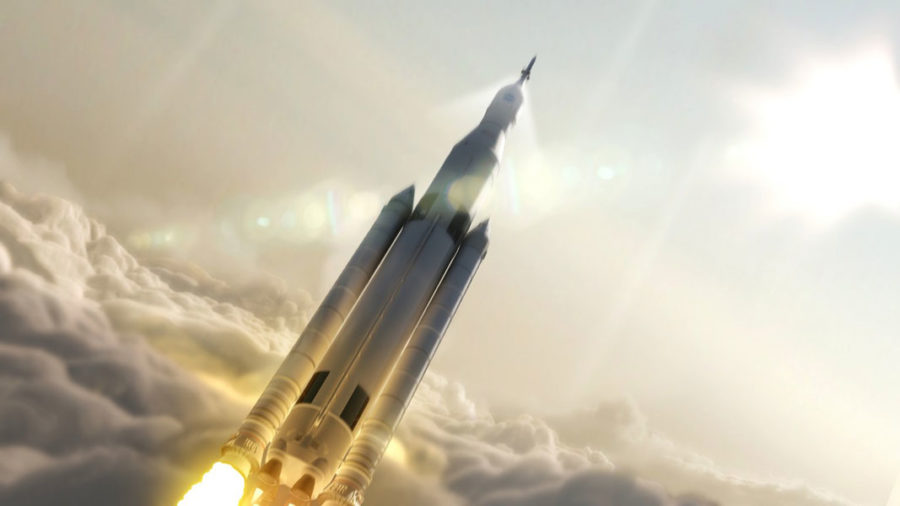SLS: Is it worth it?
March 25, 2019
NASA’s future super heavy-lift rocket, the Space Launch System (SLS), is one of NASA’s biggest projects. It has been in development for many years now, but instead of the objective of learning the secrets of the universe, or learning how plants can grow in zero gravity, the SLS will continue the goals of a NASA we haven’t seen in many years: the “space race” era of NASA.
According to NASA Lead Administrator Jim Bridenstine, SLS will continue the goals that we left behind decades ago. The SLS is what the U.S. will use to go back to the moon, and stay this time. “What SLS represents is a key piece of American architecture that is going to enable us to do more than we have ever done before,” Bridenstine said during a tour at Marshall Space Flight Center in Huntsville, Ala.
This will be one of NASA’s biggest steps in history, a big step back to the moon, a big step into the future. But for anyone who has been keenly following SpaceX, or even Blue Origin, they will see a dire problem.
Both SpaceX and Blue Origin are private aerospace companies, one more well known than the other, but they both have their own bold plans for future rockets. As of now, SpaceX is working on its Big Falcon Rocket while Blue Origin is planning to develop its New Glenn. Although both will be from private companies, it is likely that SpaceX’s super heavy-lift rocket, and even Blue Origin’s heavy-lift rocket, could be much more reliable than NASA’s SLS.
Both of these rockets beat the SLS in the most important factor: reusability. Both the BFR and New Glenn will be reusable because of their capability to land, with the BFR even being 100 percent reusable. The SLS, however, won’t be reusable at all. This is a step backward.
If the SLS were made in the age of the space shuttle, it would be more practical. Before the launch of the Falcon Heavy last year, there were only three super heavy-lift rockets that existed: the space shuttle, Saturn V, and the Soviet Energia. A rocket that qualifies as super heavy-lift has to be capable of lifting more than 50 tons into low earth orbit (LEO). And in the age of the space shuttle, it would be the most powerful rocket in the world, capable of lifting around 77 tons into LEO, according to Space.com.
But in the new age of super heavy-lift rockets, the SLS is almost unable to keep up in many areas. Its most notable competitor is SpaceX’s BFR.
The BFR, likely to be put into use by 2020, along with the SLS, is vastly superior in many aspects. Aside from reusability is its cost. According to Arstechnica, a single launch of the SLS could be anywhere between $1.5 to 2.5 billion, a staggering price tag compared to the Falcon Heavy’s $90 million per launch.
The BFR would not only be more powerful, but even cheaper. During Elon Musk’s 2017 Making Life Multiplanetary conference, he mentioned that the BFR could be cheaper to launch than their first rocket, the Falcon 1, which cost between $7 and 8 million per launch. With an estimated price of $7 million per launch, that puts it anywhere between 210 and 350 times cheaper than the average SLS launch, depending on its final cost. The sheer power of the BFR makes this price even more fascinating, as it is capable of carrying 150 tons to LEO, twice as much as SLS’ 77 tons.
At that price, the BFR renders the SLS practically obsolete. At most, the SLS could launch twice a year with its hefty price tag, but the BFR could launch up to 50 times a year. Even the New Glenn, which would only have half as much lifting capability of the SLS at around 45 tons, would be a more viable option as a rocket because of its reusability and price per launch, which would be less than $150 million, according to CNBC.
All of these faults with NASA’s “future rocket” are faults that people should pay attention to, but it’s still not reasonable to claim that the SLS should be canceled. The SLS has been in development since 2014, and more than $18 billion has been put into the project. The rocket still deserves a couple of years of service before its practicality is sunk once the BFR is put into use.
The fact that the SLS is not up to the times is not NASA’s fault. The real problem is changing authority. It is the fact that NASA’s budget takes up only 0.49 percent of the country’s annual budget. It’s the fact that with every new president, the goals of NASA are forced to change. Projects are shelved and delayed to make room for new ones. The SLS is, unfortunately, one of these forced goal changes, and now it’s becoming all too obvious that maybe the SLS just isn’t worth it.


